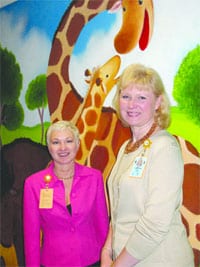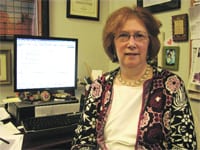Through a Child’s Eyes Baystate Children’s Hospital Catches the Spirit
It’s an unlikely question: can going to a hospital be fun?
“One family told us, ‘if this was a hotel, I’d come back again,’” said Deborah Smith, a nurse at Baystate Medical Center whose title is ‘culture change coordinator.’ She was speaking of the the Children’s Hospital at Baystate, and she knows that nothing short of a complete … well, culture change could elicit a response like that.
And that has been the goal at that pediatric hospital through a coordinated program called Spirit of the Child — an effort to see the hospital through a child’s eyes and offer the sort of amenities that young constituency would appreciate.
It seems to be working. “The family told us, ‘don’t misunderstand; we don’t want to come back, but our experience was better than we ever expected,’” Smith said.
Molly Gray, director of Women’s and Infants’ Services and the Children’s Hospital, is gratified that the changes — which run the gamut from improved food service and lively murals to personal guides assigned to each family — are making a difference. Such changes, she said, are even more important at a time when much pediatric care once given in the hospital setting is now being delivered in outpatient settings.
As a result, “the patients you see in the hospital, increasingly, are medically complex, chronically ill children” — kids who return to the hospital multiple times, or are admitted for extended stays, and are by any measure in need of some TLC.
Good Memories
Two years ago, Gray said, Baystate’s senior leadership discussed the future of the children’s hospital during a retreat.
“We said, ‘we’ve got the market share. We’re the children’s hospital in Western Mass. We have some very sophisticated programs and lots of subspecialists in pediatrics, cardiology, and neurology,’” she said. “So we asked, ‘what can we do next?’ We want to become a world-class children’s hospital. How do we distinguish ourselves from other children’s hospitals?’”
The answer, she said, has much to do with quality, cutting-edge care, but it shouldn’t stop there.
“Everyone in health care thinks they’re doing patient-centered work, but we want to customize health care for each patient, in each encounter, at any given time of day,” Gray said. “We have a vision of creating high-quality, safe, positive, memorable health care experiences. All hospital stays are memorable, of course, but not always in a good way. We want to take every decision back to, ‘what’s right for this patient and this family today?’”
This customized care is perhaps most dramatically demonstrated by staffers known as “experience guides” who provide personal attention to anxious patients and often stressed-out families.
“The experience guides personalize the care and welcome patients into their unit,” Smith said. “The nurses are great and absolutely make patients their main focus, but they may be in another room when the patient needs more time immediately.
“When the patient and the family step on the floor, they’re welcomed and escorted to their room, and they talk about various things: where the bathrooms are, how to navigate around the hospital. Even before the nurse or the physician, the guide is the first contact, telling the patient, ‘we know you don’t want to be here or deserve to be here, but we’ll treat you as well as we can and help you as much as possible while you’re here.’”
Families need that kind of treatment too, Gray added. “Parents have told us, ‘it’s all about our son right now, and making sure he survives a critical illness … but it sure would be nice if someone could tell me where to get a cup of coffee or make a cell phone call safely.’”
The personalization of care continues at Baystate High Street Health Center Pediatrics, which has adopted a philosophy called ‘open access.’ Here, waiting lists for appointments have been banished, and physicals and follow-up appointments are provided within two weeks from the day families call, which minimizes no-shows.
Patients are also assigned to one of six teams named after Dr. Seuss characters — the Cat in the Hat, Horton the Elephant, Yertle the Turtle, Hop on Pop, the Lorax, and Fox in Socks — so children are more likely to be seen by their primary provider or another provider from the same team who is familiar with the child’s records.
Just for Fun
Back at the hospital, the hotel analogy at least one family made isn’t too odd when applied to amenities such as the room-service offerings targeted specifically at the tastes of the younger set. The hospital’s chefs and nutritionists created two menus, one for children and one for teens, that include pasta, dinosaur-shaped chicken nuggets, string cheese, soy yogurt, macaroni and cheese, and a build-your-own-sandwich platter.
The hospital conducted a taste test with its young patients to make sure they liked the choices, and meals are no longer served at one set time — perfect for a late sleeper who can order breakfast at, say, 10 a.m. instead of waking up to a tray of food long gone cold. One benefit, Gray said, is that the flexible menu encourages patients to maintain their nutrition, which often suffers in a traditional hospital setting.
In addition, the hospital has commissioned large, colorful wall murals in various areas, including the North Café and the neonatal intensive care unit, and work has begun in the Adolescent Unit on a teen center equipped with a large, flat-screen television and DVDs, a satellite boom box and CDs, video games, computers with Internet access, and a library of books.
Smith said Baystate employees involved in the Spirit of the Child changes made an effort to remember their own childhoods and ask themselves what features they would have enjoyed.
“We’re nurturing the kid within and asking what it would be like if kids ran the hospital,” Gray agreed, adding that part of creating a child-friendly atmosphere is providing a better, more efficient work environment for nurses and other staff. “It’s exhausting work, and caregivers need to be replenished during the work day.”
It’s not all about fun, of course; Smith said the added focus on the patients has manifested itself in clinical ways as well. For instance, the hospital took to heart complaints about a procedure that pumps room-temperature saline into the bladder. Within six weeks, the hospital had purchased a saline warmer.
“That’s record time for a hospital of this size to make a change like that,” Gray said.
“For us, all this is really a different way of approaching everything we do,” she added. “The creative ideas coming from the staff and physicians have been amazing. I mean, no child should have to grow up in a hospital, but some children do. We want to show them that they’re welcome here.”




Comments are closed.